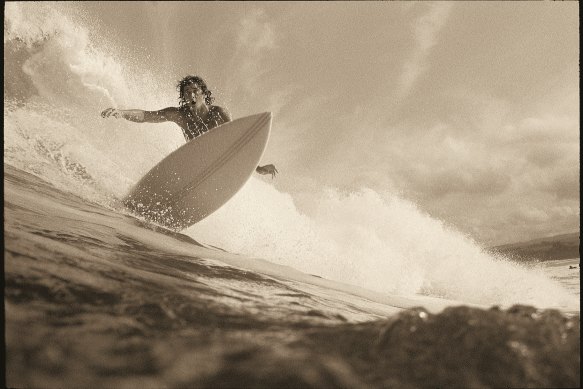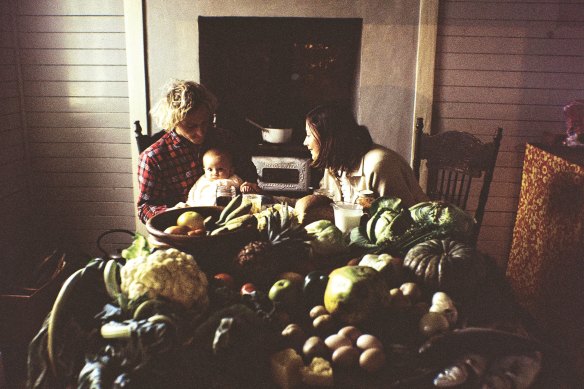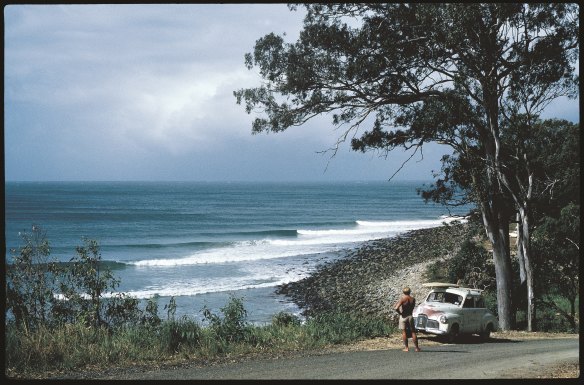These iconic images are so powerful they create ‘false memories’ in some people
By Malcolm Knox
John Witzig’s photographs are tied so closely to the seminal 1960s in Australian surfing, it’s tempting to wonder if that golden age would ever have happened without them (in the sense of a tree falling in a forest).
Nat Young became not just a surfer but an icon of the period through Witzig’s photographs; likewise, Bob McTavish, Wayne Lynch, Ted Spencer and the breaks they surfed in Australia and Hawaii. Witzig thought he was only taking pictures of “my friends who became famous”, but he ended up creating an Australian folklore.

Mark Richards at Haleiwa.Credit: John Witzig
“Without the photographs I think that period would be profoundly different, I really do,” Witzig says. “I have a very visual memory, so I’m probably the wrong person to ask, but that period would be extraordinarily different if we were just going by oral storytelling.”
The 24 Witzig photographs on display at the Dickerson Gallery are already iconic (there’s no escaping the word). Some are in the water, such as a famous “headless” McTavish or Richards on the apex of a turn, and others are out of it, like Peterson “radiating suspicion” on North Narrabeen beach or surfers Baddy Treloar and Owl Chapman in a car park at Fairy Bower in Manly.
Young, in various moods, was a favourite subject. Witzig’s photograph of perfect deserted waves at the National Park break at Noosa, waiting for surfers to come and get them, evokes an ache of freedom even for those born years too late to experience it.
So powerful have the Witzig photographs become in surfing mythology, they have created false memories. “There’s a lot of people who have told me they were there, or they could remember it, when they were not,” he says.

Country Soul is one of Witzig’s favourites.Credit: John Witzig
Witzig was a Sydney schoolboy, and then an architecture student, when he started taking photographs on the northern beaches where his family had a holiday house. “I got my driver’s licence when I was 17, which was in 1961,” he says, “so I suddenly got a chance to move around the northern beaches. And you sort of almost knew somebody at every beach.”
He began shooting with a Box Brownie before turning to surf photography, borrowing a camera and lens from the well-known photographer Ron Perrott and freelancing for Bob Evans’s Surfing World magazine.
Influenced by Henri Cartier-Bresson, Witzig shot in black and white initially; some of his best-remembered shots would remain in monochrome until he began using colour in the 1970s.
In 1970, Witzig co-founded Tracks magazine with Alby Falzon and David Elfick. He saw himself more as a magazine writer, designer and publisher than photographer. He processed his own film, but “my pictures lay completely ignored by me and everyone else for at least 20 years or so.”

Bob McTavish and the ’48 Holden, Noosa, 1966.Credit: John Witzig
“The change happened,” he says, when surf entrepreneurs “began to take an interest in the ’60s, that decade that refuses to die”.
So began the making of icons, blending surf photographs with counterculture imagery. One of Witzig’s favourites is Country Soul, a peaceful portrait of parents and baby at a table of home-grown vegetables. Then there is a lone surfer at his car overlooking an empty Nationals break at Noosa around 1964, which Witzig was pressured against taking and publishing.
“There were various people who didn’t want photographs taken of Noosa,” he says.
Among his in-water shots, Witzig’s favourite is of four-time world champion Richards at Haleiwa in Hawaii in 1976, a lightning-strikes moment.
‘He’s so close to whacking me on the head with his board, but Mark Richards was a good enough surfer not to do it.’
John Witzig
“I was holding the camera out in my right hand, so I wasn’t even looking through the viewfinder,” Witzig recalls. “I was just pressing the shutter when my judgment told me that it was the right time to do it. He’s so close to whacking me on the head with his board, but Mark Richards was a good enough surfer not do it.
“It’s also unbelievably sharp because the 35mm lens on that Nikonos was an absolutely brilliant Nikkor lens, and everything is sharp about it. His expression, the way the water is coming off the board, and in the far right-hand side of the frame there’s someone paddling out. As a composition, it’s absolutely superb, and I can’t really claim any credit for it.”
At 80, Witzig can claim some credit for the body of work, if not for the memories others have embroidered around them. “There’s always someone who’s looked at the photos for so long, they’ll tell me they were there. I can’t talk them out of it.”
The Show After the Last One, Dickerson Gallery, Woollahra. Until October 26.
The Booklist is a weekly newsletter for book lovers from books editor Jason Steger. Get it delivered every Friday.